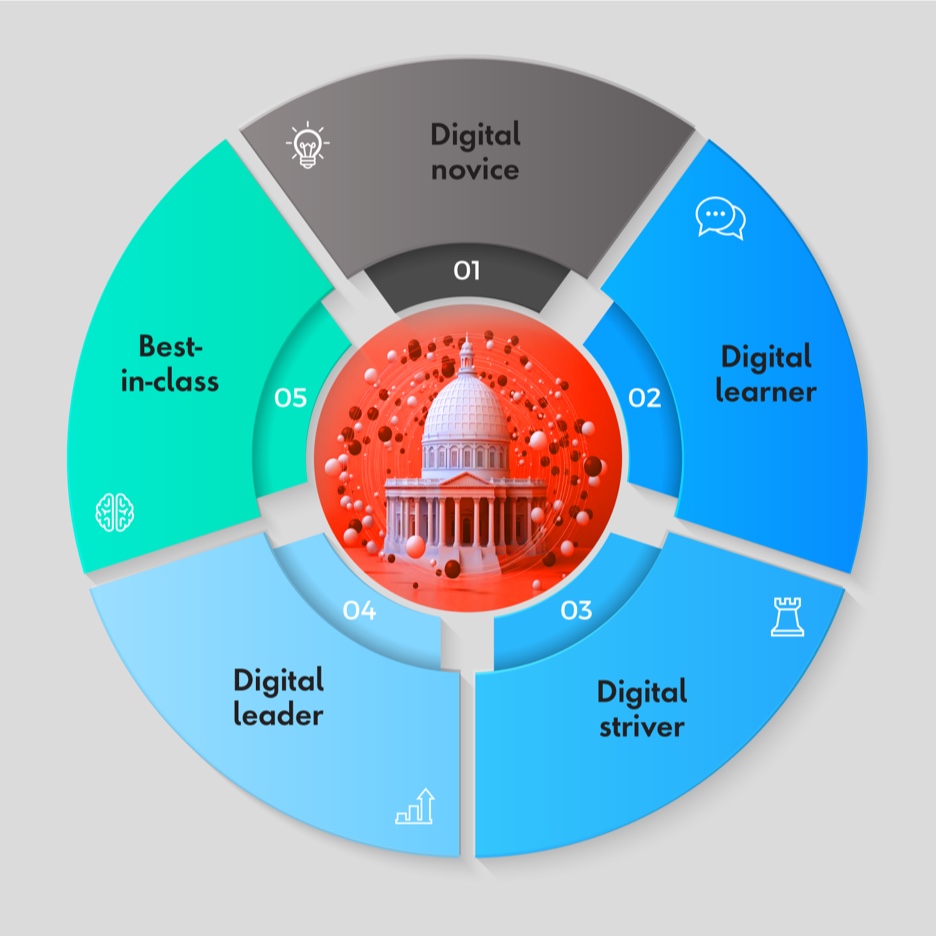What issue can we solve for you?
Type in your prompt above or try one of these suggestions
Suggested Prompt



Public Sector
The Digital Transformation Index: A Roadmap to Digital Excellence in Government
Digital transformation within the public sector realm focuses on the ongoing application of modern technology to improve the outcomes and performance of agencies.
Across the globe, governments at all levels are undergoing digital transformation to deliver their services more efficiently, transparently and effectively. It is improving the quality of service and mission outcomes, as well as improving the cost at which those services are delivered.
Digital transformation in the public sector has become an imperative rather than something that is “nice to do.” Just like in the commercial sector, the U.S. government finds itself engaging with citizens who have become more digitally capable and who expect more digitally intuitive services. Citizens and customers alike are accustomed to one digital level with commercial applications and want to continue at that level when dealing with government agencies.
To achieve their digital transformation objectives, agencies must engage in effective measurements.
From data to direction: How government agencies can measure their progress toward digital maturity
The U.S. is among the top ten countries globally when it comes to e-government according to a United Nations e-government survey used in the Global Innovation Index. However, within each of the top ten countries and especially within the U.S. government, there are agencies that are at different levels of digital maturity.
To reach higher, more consistent levels of digital maturity, government organizations need a clear, consistent and data-driven approach to navigate their digital transformation journey. The Digital Transformation Index (DTI) provides this approach, offering a comprehensive view to measure digital maturity, identify strengths and opportunities, map solutions, prioritize investments and benchmark performance.
Agencies need not spend enormous amounts of time measuring their performance. Rather, they should have a handy, agile and useful index to help them understand the situation at hand so that they can design or improve their digital roadmap.
Developed by Publicis Sapient, the DTI is a tool that empowers government organizations to develop a data-driven vision and roadmap for digital excellence. It provides a holistic view of an organization's digital maturity across various capabilities, helping them understand where they stand in their digital transformation journey. This index was originally pioneered in the commercial space during the COVID-19 crisis when digital ways of working became more important than ever.
Components of the DTI framework

The Digital Transformation Index (DTI) employs a structured framework to methodically evaluate digital maturity. This evaluation encompasses three primary categories, each subdivided into nine distinct subcategories. This framework is designed to provide a granular analysis of an organization’s digital capabilities. By offering a detailed and nuanced view, the DTI framework facilitates a comprehensive understanding of an organization’s digital maturity level, essential for strategic planning and decision-making.
Value creation and exchange
How an organization creates and delivers value in the digital age is the first component of the framework.
- Digital strategy and innovation: assesses the organization's ability to develop and implement a clear, coherent digital strategy that aligns with its overall business objectives. It also looks at the organization's capacity for digital innovation, including its ability to leverage digital technologies to create new business models, products and services.
- Customer centricity: evaluates the organization's ability to put the customer at the center of its digital strategy. It includes the organization's ability to leverage digital technologies to enhance customer experiences, meet customer needs and build strong customer relationships.
- Governance: looks at the organization's governance structures and processes for digital transformation. It includes the organization's ability to manage digital risks, ensure data privacy and security and comply with relevant regulations.
Operating model
The framework considers the organization’s current digital maturity and how it operates in the digital age, including:
- Agile ways of working: assesses the organization's ability to adopt agile methodologies and practices, which are crucial for rapid, iterative development in the digital age.
- Cross-functional alignment: evaluates the organization's ability to break down silos and foster cross-functional collaboration, which is key to delivering integrated, end-to-end digital solutions.
- Organizational structure: looks at the organization's structure and whether it supports or hinders digital transformation. It includes the organization's ability to create a digital-friendly culture, develop digital skills and capabilities and attract and retain digital talent.
Data and technology
An organization's use of data and technologies within its digital transformation efforts and/or other projects are essential to the journey.
- Data availability and use: assesses the organization's ability to collect, manage and use data effectively to drive its digital transformation efforts.
- Analytics and measurement: evaluates the organization's ability to use analytics and measurement tools to track its digital transformation progress, make data-driven decisions and generate insights.
- Tech infrastructure and enablers: looks at the organization's technology infrastructure and its ability to leverage technology enablers (like cloud computing, AI and IoT) to support its digital transformation efforts.
Each of these elements and subcategories plays a crucial role in an organization's digital transformation journey. The DTI assesses the organization's maturity in each of these areas, helping it identify its strengths, weaknesses and areas for improvement.
Five levels of maturity in the journey to government agency transformation
The DTI uses a five-point scale to assess where government agencies are on their journeys to digital maturity. Each stage of this scale represents a step forward in an organization's digital transformation journey.
Digital novice
This is the starting point of the digital transformation journey. Organizations at this stage are just beginning to explore digital technologies and their potential impact. They may have some digital initiatives in place, but these are often disjointed and lack a clear strategy or vision. The focus at this stage is on building awareness and understanding of digital technologies and their potential applications.

Digital learner
At this stage, organizations have moved beyond awareness and are actively experimenting with digital technologies. They are starting to develop a digital strategy and are beginning to see some benefits from their digital initiatives. However, these initiatives may still be somewhat isolated and not fully integrated into the organization's overall strategy and operations.
Digital striver
Organizations at this stage have a clear digital strategy in place and are making significant investments in digital technologies. They are seeing tangible benefits from their digital initiatives, which are now integrated into their overall strategy and operations. However, they may still face challenges in fully leveraging these technologies and transforming their organization.
Digital leader
At this stage, organizations are at the forefront of digital transformation. They have a mature digital strategy and are fully leveraging digital technologies to transform their operations and deliver superior value to their customers. They are also actively innovating and experimenting with new digital technologies and approaches.
Best-in-class
These organizations are the trailblazers in digital transformation. They are not just leveraging digital technologies but are shaping the digital landscape. They have a highly mature digital strategy and operations, and they consistently deliver exceptional value to their customers through their digital initiatives. They are also recognized as leaders and innovators in the public sector and/or across industries.
The goal is to progress from being a digital novice to becoming best-in-class, fully leveraging digital technologies to transform operations and deliver superior value.
Key considerations for government digital transformation
There are numerous challenges in implementing digital transformation within the public sector. There are data privacy and security concerns, budgetary considerations, procurement process limitations and regulatory compliance requirements that may slow down the pace of transformation. Clearly, there is a significant challenge in terms of change management and the skills gap faced by the agencies, as well as ever-increasing citizen expectations.
All these challenges should not prevent progress. A 1,000-mile road starts with the first mile. When implementing digital transformation, here are some pointers that agencies should consider.
Let's unlock the digital potential of government together.
The Digital Transformation Index is more than just a measurement tool. It's a roadmap to digital excellence. The DTI can provide value to government organizations by offering a clear understanding of their strengths and opportunities in their digital transformation efforts. It helps these organizations map out solutions and prioritize investments based on their current digital maturity level and their desired future state. Moreover, the DTI may allow government organizations to benchmark their performance against industry standards and best practices. This helps them identify gaps in their digital capabilities and develop strategies to close these gaps. It empowers government organizations to develop a data-driven vision and roadmap for their digital transformation journey, providing valuable insights into their digital maturity, strengths, opportunities and performance.
Related Reading
-
![]()
Insight
How Residents Will Navigate Government Services as Gen AI Evolves
Learn more about how people are using generative AI, and how it can help government agencies reach faster and better public sector outcomes.
-
![]()
Insight
Government Communications is at the Heart of CX Management.
Government agencies must improve their communications strategy and practice in order to increase the trust of their citizens and to better serve the public sector.
-
![]()
Insight
How to Adopt a Product Mindset to Drive Public Sector Services
Win the trust of your citizens and transform your organization toward a product mindset by following these five Public Sector pillars of success.








